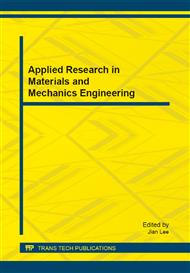p.24
p.30
p.35
p.39
p.44
p.50
p.56
p.61
p.65
Characterization of Electrospinning Polycarbosilane Fiber with the Concentration of N,N-Dimethylformamide 22%, 24%, 26%, 28% and 30%
Abstract:
Polycarbosilane (PCS) fibers have been made using a solvent which is a mixture of N,N-dimethylformamide (DMF) in toluene. Polycarbosilanes (PCS) obtained from NaBond with concentration 1.2 g/ml dissolved in solution toluene and N,N-dimethylformamide (DMF) was stirred gently for 24 h at ambient temperature. DMF was mixed with toluene at ratios 22%, 24%, 26%, 28% and 30%. Electrospinning apparatus (nanoE-Spinning) from NaBond was used. In a vertical electrospinning set up, the solution in a glass syringe delivered to the tip of a 6-gauge (0.5 mm inner diameter) stainless steel needle. The tip to collector distance was adjusted to 100 mm with applied high voltage at 10kV. A stainless steel plate with dimension 100 mm x 100 mm wrapped by aluminum foil was used as collector. The electrospinning non-woven fiber was cured at temperature 200°C (2°C/min), for 1h, 1.5h, and 2h, and fibers with DMF concentration 30% was also pyrolysis at 1000 °C for 3 h in inert atmosphere. The samples were tested and observed with FTIR spectroscopy, and SEM-EDS apparatus. The results showed that PCS fibers can be made from dissolving PCS with toluene with the addition of DMF to increase the polarity of the solvent and the formation of fibers is done by using electrospinning which is supported by the presence of voltage from the outside. Fiber curing is done at 200 °C to evaporate the toluene, the DMF, and resulting stronger fibers than before. The addition concentration of DMF in toluene and curing time will affect the composition of the resulting PCS fiber. Curing time on PCS fibers will affect the composition of solvents such as DMF and Si-H bond on which to assert their PCS fiber cross linking conditions. PCS fiber morphology is known of changes in fiber diameter and fiber uniformity. Smallest PCS fiber average diameter 4.81 μm resulted from 28% DMF with curing time 2 hours and the largest achieved from 22% DMF with curing time 1 hour around 14.22 μm. Composition of pyrolyzed fiber was SiO0.587C0.413, with average density 3.1033 g/cc and average diameter the fiber was 3.06 μm.
Info:
Periodical:
Pages:
44-49
Citation:
Online since:
August 2014
Authors:
Keywords:
Price:
Сopyright:
© 2014 Trans Tech Publications Ltd. All Rights Reserved
Share:
Citation:


